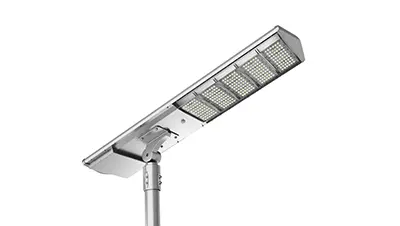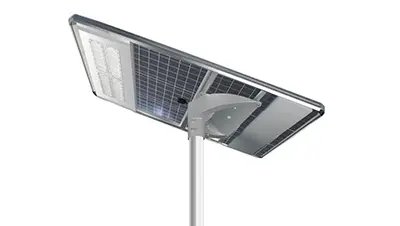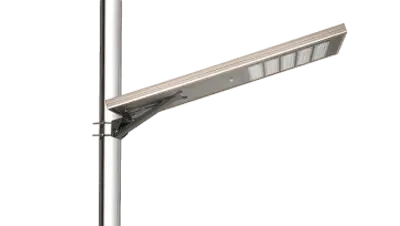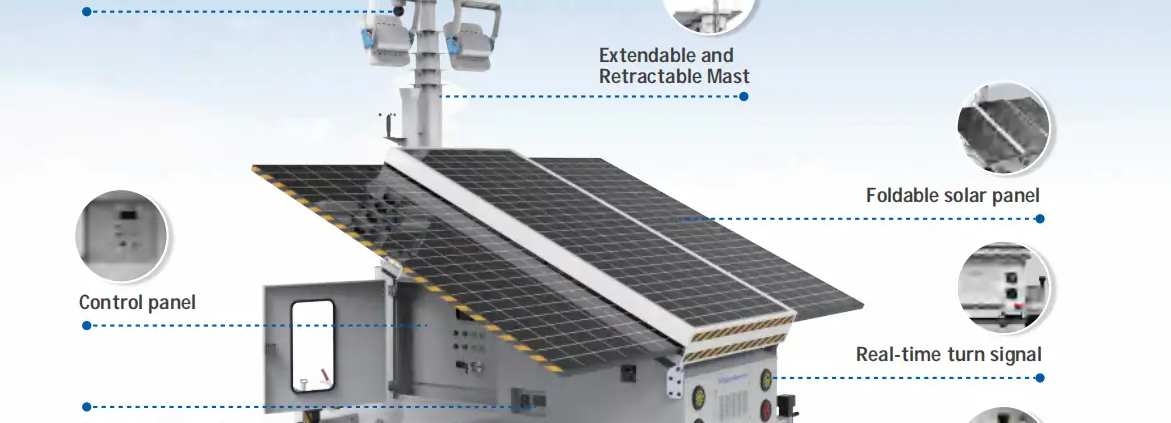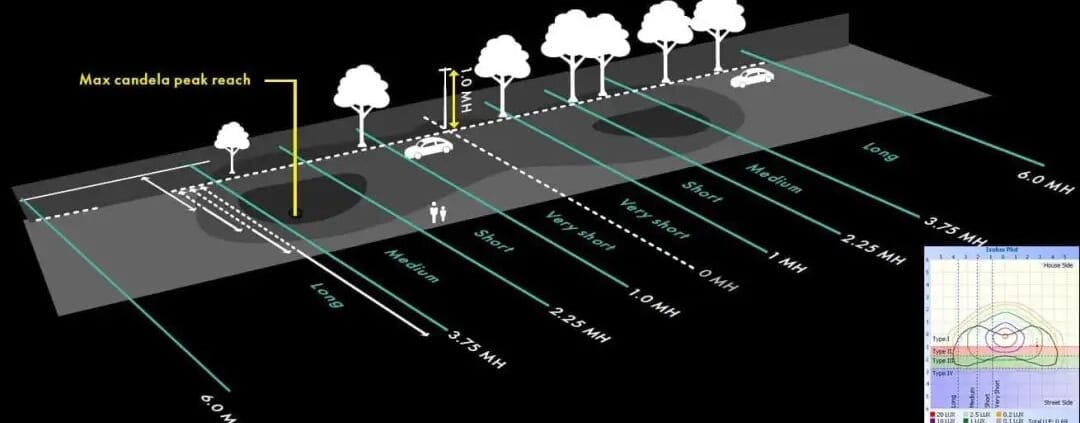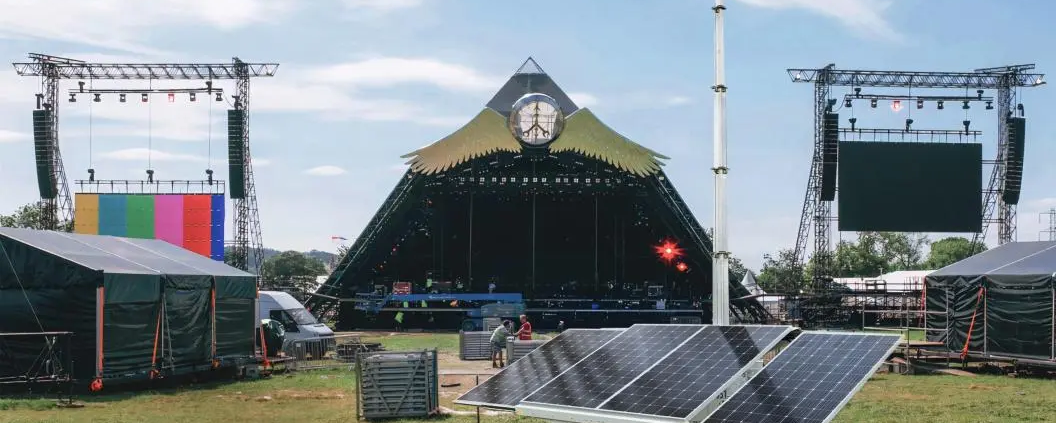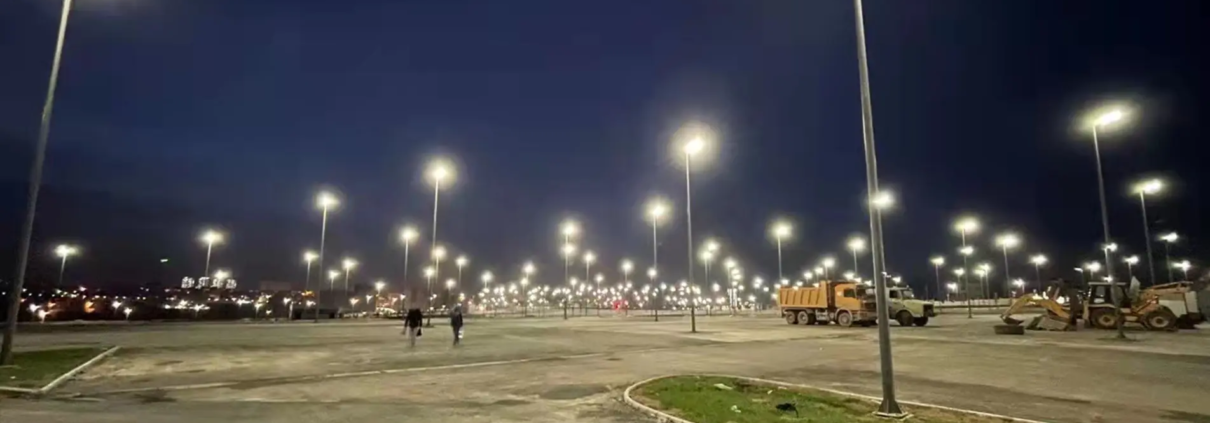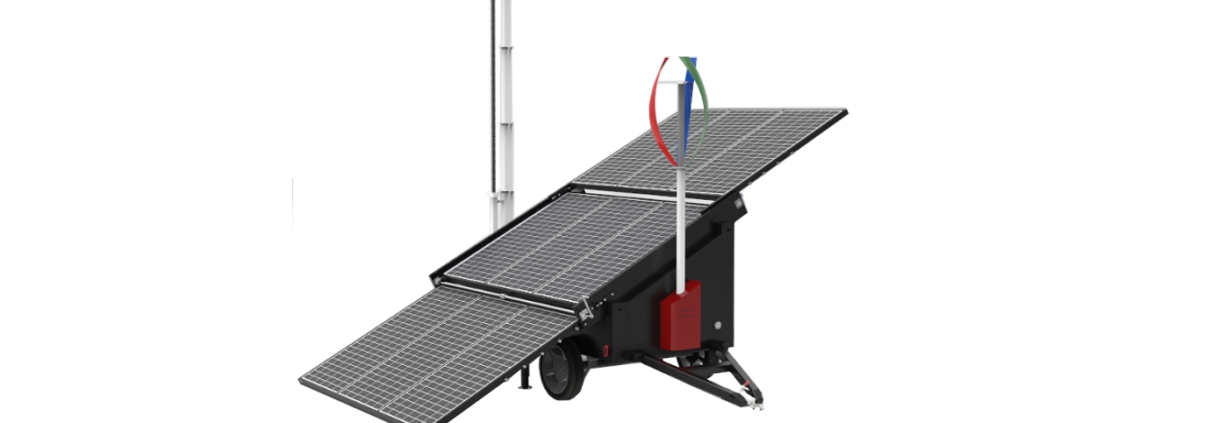Solar street light Sadui Solution and Best Product Type
1. Standards Compliance
- This proposal strictly follows the Saudi standard SASO 2927:2019 (Road Lighting Energy Efficiency and Functional Requirements). This standard mandates that LED streetlights must pass energy efficiency registration (EER certification), ensuring the product meets the Saudi standards for lifespan, lumen maintenance, switching cycles, etc. Uncertified products are prohibited from import.
2. Brightness Selection
- Illuminance (Lux): According to Saudi road lighting standards (referencing CEN/TR 13201-1), the average illuminance for main roads should be ≥20 Lux, with uniformity (minimum/average illuminance ratio) ≥0.4; for secondary roads, it should be ≥10 Lux, with uniformity ≥0.35. The proposal recommends an illuminance of 20-30 Lux for main roads, with uniformity <1.5 (achieved through optical design optimization).
- Luminous Flux (Lumens): Depending on the road width and height, the recommended luminous flux range for the light source is 10,000–20,000 lumens. For example, 8-10 meter lamp poles require an output of 12,000–15,000 lumens.
- Light Efficiency (lm/W): LED light sources should have an efficiency ≥130 lm/W to ensure energy saving (as required by SASO 2927).
- Uniformity: The illuminance uniformity (Uo) should be ≤1.5, achieved through lens or reflector design to avoid dark areas and glare.

3. Color Temperature Selection
- The recommended color temperature is 4000K–6000K. This range provides high visual clarity, reduces fatigue, and meets the high-temperature environmental needs of Saudi Arabia (high color temperatures help enhance alertness). Avoid temperatures below 3000K (too warm).
4. Height Design and Materials
- Lamp Pole Height: Based on road type:
- Main roads: 10–12 meters (covering 4-6 lanes).
- Secondary roads or local streets: 6–8 meters.
- Lamp Pole Material: Made of hot-dip galvanized steel (corrosion-treated) or aluminum alloy (lightweight), wind resistance ≥150 km/h, suitable for Saudi desert climate. The base design must meet wind load resistance standards (e.g., EN 40-5).
5. Color Rendering Index (CRI)
- CRI ≥80 (minimum requirement of SASO 2927), recommended CRI ≥90 to ensure true color reproduction (especially suitable for urban landscape roads). A high CRI reduces visual errors and enhances safety.

6. Street Light System Design Configuration
- Continuous Lighting Days: Design autonomy for 5 consecutive rainy days. Saudi Arabia has abundant solar resources (annual average radiation of 2,200–2,500 kWh/m²), but considering the impact of dust storms, the battery capacity should be redundant.
- Battery Configuration: Lithium Iron Phosphate (LiFePO4) battery, 12.8V or 25.6V systems, with a cycle life of >5,000 times.
- Solar Panel: High-efficiency monocrystalline solar panel, conversion efficiency ≥21%, matched with an MPPT controller to improve charging efficiency.
- System Configuration Example (for main roads):
- LED light source: 100W (luminous flux 14,000 lumens).
- Solar panel: 18V/300W (monocrystalline).
- Battery: 12.8V/100Ah (Lithium Iron Phosphate).
- Controller: MPPT type, with intelligent dimming capability.
7. System Optimization: Automatic Lighting Control
- Intelligent Control Features
- Light Control + Time Control: Automatically turns lights on and off based on ambient light (on at dusk, off at dawn).
- Adaptive Dimming: Reduces power by 50% automatically during low traffic after midnight (as per SASO energy-saving requirements).
- Motion Sensors: Optionally equipped with human sensors to increase brightness when people or vehicles approach.
- Remote Monitoring: Allows fault diagnosis and energy consumption management through the IoT platform (like 4G/5G).
8. Sadui Best Solar Street Light Recommendations from Luxman Light
Based on Luxman’s products https://luxmanlight.com/led-solar-street-light-outdoor, we recommend the following product series (products comply with SASO 2927 certification), all meeting the above lighting conditions and indicators.
ALL IN ONE SOLAR STREET LIGHT – MY SERIES
- Integrated design
- Maximum Autonomy 5~7 rainy days
- Remote Control
- Color Temperature: Customizable
- LED Light Efficiency: ≥130 lm/W
- Solar Panel: Conversion Efficiency ≥21%
HIGH LUMEN SOLAR STREET LIGHT – HS SERIES
- 15,000lm to 20,000lm
- Maximum Autonomy 2-3 rainy days
- IP66 Waterproof
- Color Temperature: Customizable
- LED Light Efficiency: ≥130 lm/W
- Solar Panel: Conversion Efficiency ≥21%
LED SOLAR STREET LIGHT OUTDOOR – S2 SERIES
- Dusk to dawn sensors
- Maximum Autonomy 5~7 rainy days
- PIR sensing mode
- Color Temperature: Customizable
- LED Light Efficiency: ≥130 lm/W
- Solar Panel: Conversion Efficiency ≥21%
Summary
This proposal complies with the Saudi SASO 2927 standard, and we recommend using Luxman SolarStar product series, which has high light efficiency, intelligent control, and durability suitable for the Saudi environment. When implementing, it is advisable to prioritize pilot projects on main roads and conduct regular maintenance (such as cleaning solar panels) to maximize ROI. For customization, please contact Luxman for SASO certification details and technical support.
What are the types of IESNA streetlight light distribution patterns and their applications?
The light distribution of LED fixtures refers to the distribution, direction, and intensity of light emitted by the fixtures. It significantly impacts lighting efficiency, energy efficiency, and visual comfort. Proper light distribution can provide appropriate illuminance and uniformity, save energy, reduce glare, enhance safety, decrease light pollution, and create a comfortable lighting environment. LED lighting companies should design appropriate light distributions to ensure the advantages of their fixtures, while lighting engineers and designers should select suitable light distribution patterns based on specific needs to achieve optimal lighting effects from LED fixtures.
When a light source emits light, its propagation direction may not align with the expected direction. In such cases, specific structures (such as lenses and reflectors) need to be designed to alter the light’s propagation direction. This involves adjusting the spatial distribution of light to achieve the desired effect. This method of controlling the propagation direction of light is called the luminaire photometric curve or light distribution.
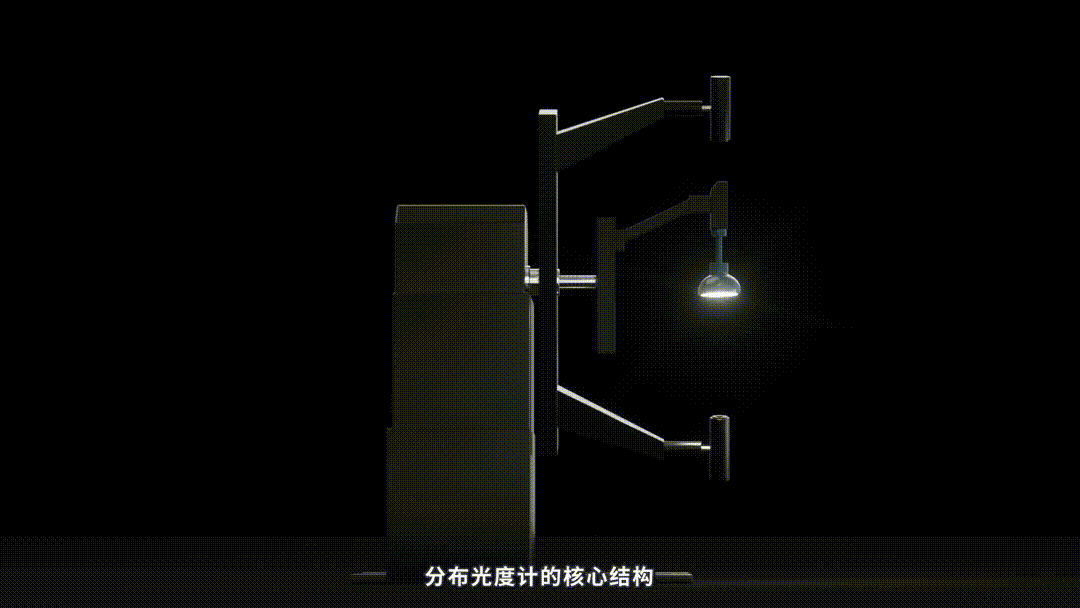
The light intensity distribution curve, commonly known as the photometric curve or light distribution curve (LDC), illustrates the spatial distribution of luminous intensity from the fixture. The intensity distribution curve is directly obtained through measurements of the fixture using a photometer. Common formats for intensity distribution curves include IES (North America) and LDT (Europe). As buyers, we can also obtain these files by contacting the fixture manufacturers. There are two methods for representing photometric curves: for floodlights, a rectangular coordinate system is generally used, while polar coordinates are adopted for indoor and roadway lighting.
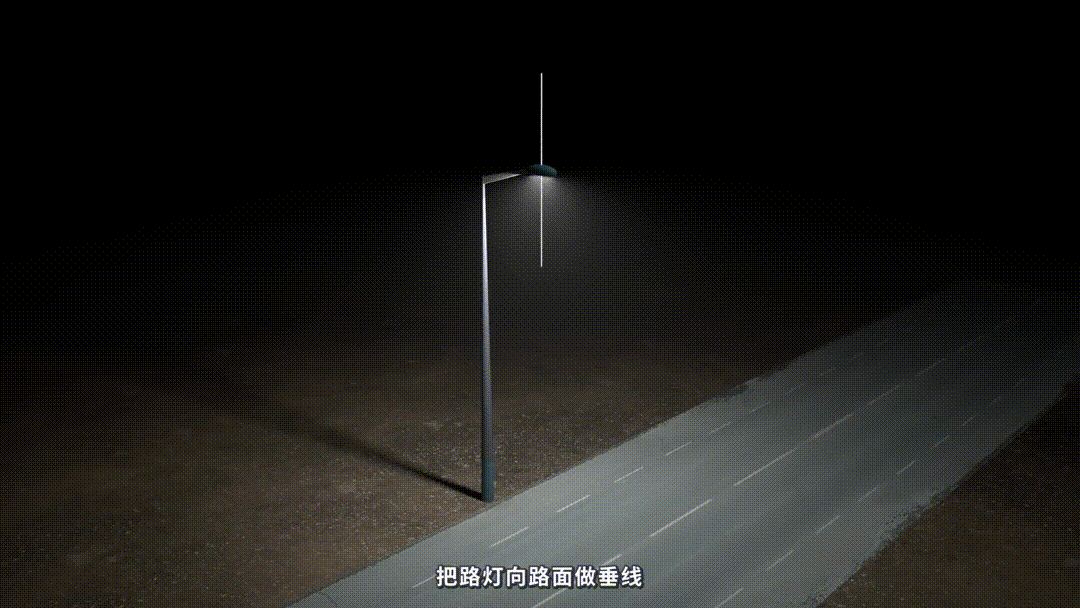
Light Distribution Curve (Polar Coordinates)
In a measurement plane passing through the center of the light source, the luminous intensity values of the fixture at different angles are measured. Starting from a certain direction, the luminous intensity at each angle is marked and represented by vectors. Connecting the endpoints of these vectors forms the polar light distribution curve/photometric curve of the fixture, as shown on the left side of the following image.
Light Distribution Curve (Linear Coordinates)
This distribution curve is typically used for devices such as LED spotlights and floodlights. Since the beams of these fixtures are concentrated in a very small solid angle, it is challenging to represent their spatial luminous intensity distribution using polar coordinates. Thus, some manufacturers use linear coordinate light distribution curves/photometric curves to represent their light distribution. The vertical axis represents luminous intensity (I), while the horizontal axis represents beam angle, as shown on the right side of the following image.
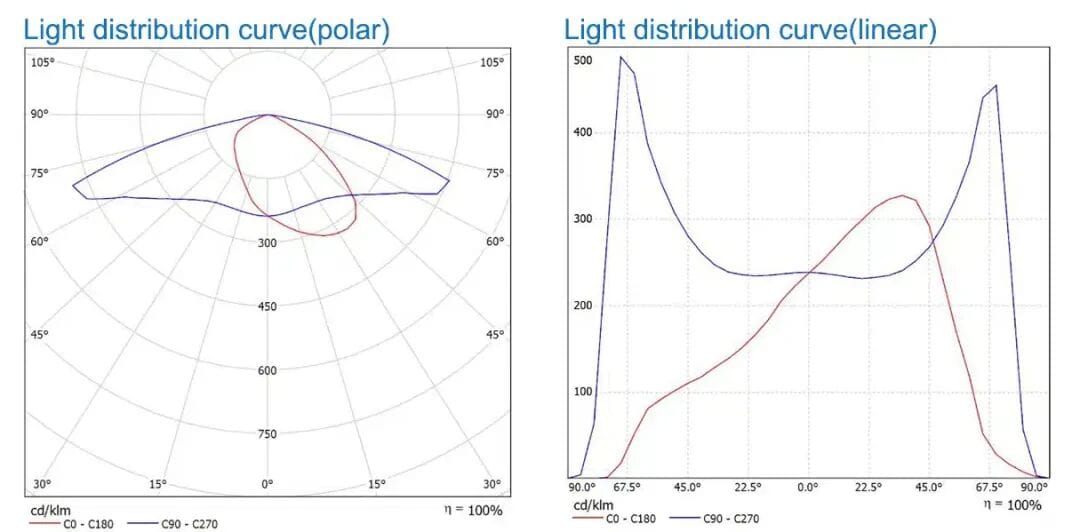
IESNA Lighting Distribution Type Classification
Since its establishment in 1906, the Illuminating Engineering Society of North America (IESNA) has a history of over a century. The classification of lighting distributions introduced by IESNA is still widely used today. The fixture distribution classification system is clearly defined in the ANSI/IESNA RP-8-1983 standard. The types of fixtures defined by the Illuminating Engineering Society of North America are standardized categories used to describe the light distribution patterns of fixtures. These lighting distribution types help lighting professionals and designers understand how fixtures produce light and how light propagates within a given area. IES defines several standard distribution types, each represented by a two-letter code. Common IES fixture distribution types include Type I, Type II, Type III, Type IV, and Type V, followed by Roman numerals (I-V), where S, M, L represent Short, Medium, and Long respectively. The specific classification is determined by the 50% and maximum intensity points of the IES file, which will be detailed in the subsequent sections.
Currently, there are many standardized formats for photometric files, with common ones including EULUMDAT, CIE102, and IESNA LM-63. IESNA LM-63 is used in North America, EULUMDAT is used in Europe, while CIE102 is used in New Zealand. The current standard from 2002 has been approved and recognized by the American National Standards Institute (ANSI). IESNA LM-63-2002 has become the dedicated photometric file format for North America, with the file extension “*.ies”.
IESNA lighting distribution types define the light distribution of fixtures more precisely based on the shape of the illuminated area. For lateral light distribution, this pattern describes how light scatters from the fixture and is characterized by the point where the intensity reaches 50%. This distribution pattern involves the fixture’s ability to project light both forward and backward. In simple terms, if you want to illuminate a single lane, Type I may be suitable; if you want to illuminate two lanes, Type II may be more appropriate. However, this is not a strict rule and is influenced by factors such as mounting height, tilt angle, arm length, and the distance of the fixture from the edge of the road. IESNA has defined five main light distribution patterns: Type I, Type II, Type III, Type IV, and Type V. These classifications are commonly used to determine suitable spectra for roads of varying widths.
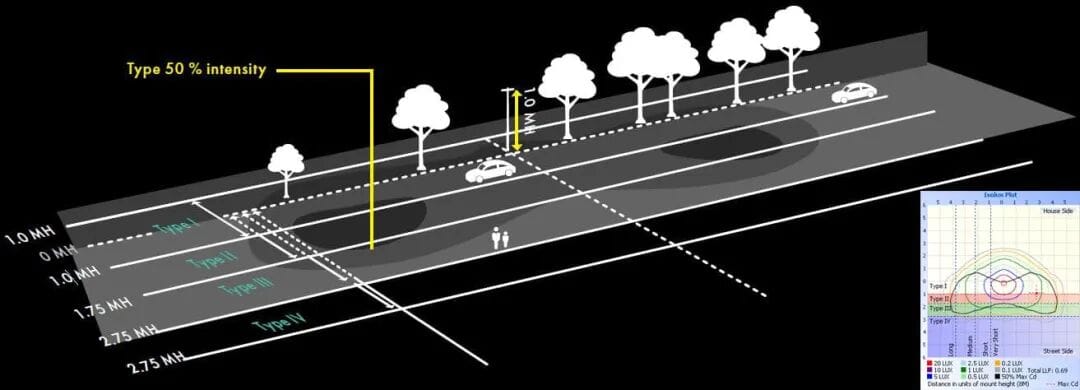
In the standards published by IESNA, the road is longitudinally divided into five regions, as shown in the above image. Lateral light distribution is classified based on the area where the 50% maximum intensity point is located. For the light distribution curves of the above fixtures, if the 50% intensity point falls within the Type III area, then its corresponding light distribution type is classified as Type III. From the diagram, we can generally infer that this distribution is suitable for three-lane roads. Different lateral light distributions are suitable for various application scenarios, as detailed below:
- Type I: 1-1 MH, when the 50% light intensity trajectory is located between 1 MH on the fixture side and the street side, we refer to it as Type I narrow symmetrical or asymmetrical light distribution. Suitable for sidewalks, paths, and single-lane roads.
- Type II: 1-1.75 MH, when the 50% light intensity trajectory is located between 1 MH and 1.75 MH on the fixture’s street side, we refer to it as Type II narrow asymmetrical light distribution. Suitable for 1-2 lane roads, main roads, and highways.
- Type III: 1.75-2.75 MH, when the 50% light intensity trajectory is located between 1.75 MH and 2.75 MH on the fixture’s street side, we refer to it as Type III wide asymmetrical light distribution. Suitable for main roads, highways, and parking lots.
- Type IV: 2.75-3.75 MH, when the 50% light intensity trajectory is located between 2.75 MH and 3.75 MH on the fixture’s street side, we refer to it as Type IV wide asymmetrical forward light distribution. Suitable for parking lots, plazas, and wall-mounted area lighting.
- Type V: Symmetrical circular pattern, with circular symmetrical distribution around the fixture, providing even light distribution both in front and back. Suitable for parking and area lighting.
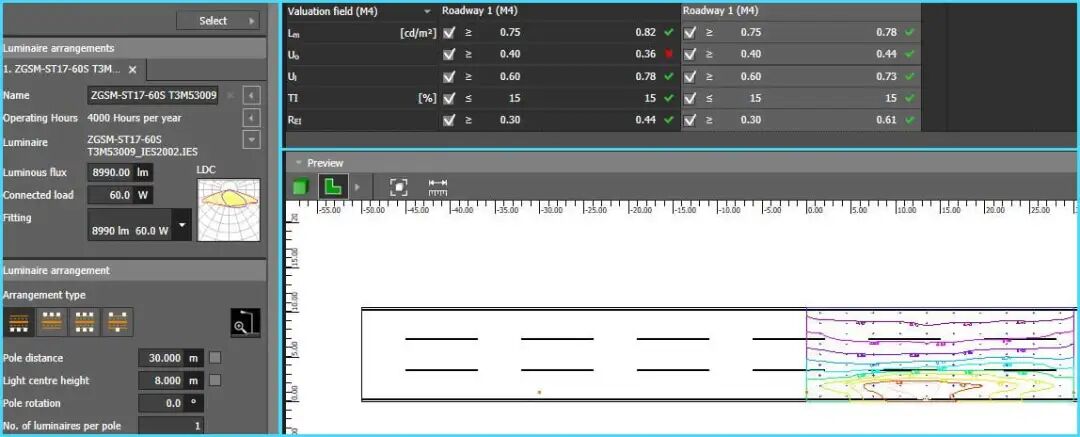
Vertical and Longitudinal Light Distribution
Vertical light distribution refers to the vertical light distribution of a fixture, based on the position of maximum luminous intensity (measured in candelas) in the grid parallel to the TRL. The road along the TRL is divided into different regions according to its distance from the TRL (expressed as multiples of installation height). Longitudinal light distribution involves the fixture’s ability to project light to the left and right sides, defined by the maximum intensity point of the fixture. According to IESNA’s definition, the “S” category applies to pole spacings of less than 2.25 times the mounting height, “M” applies to pole spacings between 2.25 and 3.75 times, and “L” applies to pole spacings of between 3.75 and 6.0 times. However, this is not a strict rule and is influenced by factors such as fixture arrangement and road conditions. Generally, fixtures classified as “S” are suitable for smaller pole spacings, while “L” classified fixtures are suitable for larger spacings.
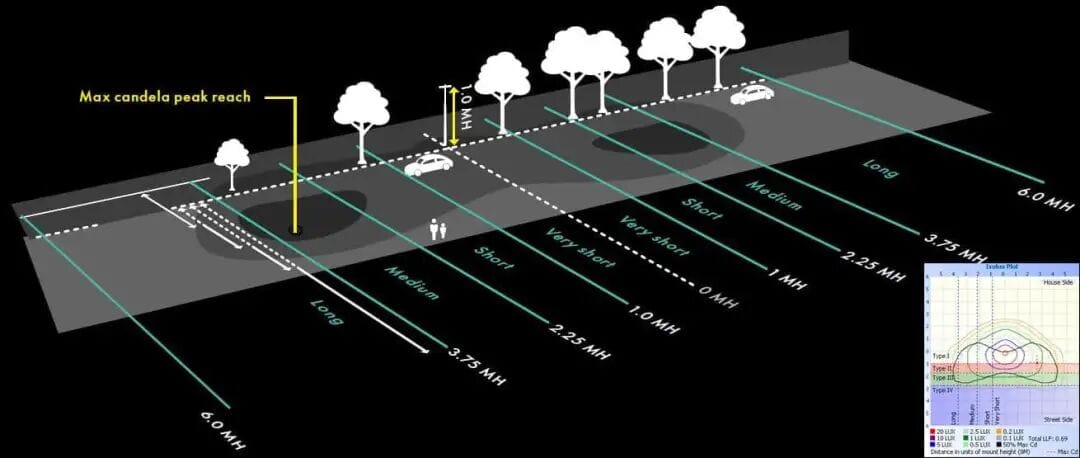
In the standards published by IESNA, the road is transversely divided into three regions, as shown in the above image. Longitudinal light distribution is classified based on the area where the 100% maximum intensity point is located. For the light distribution curves of the fixtures shown, if the maximum light intensity point of the streetlight falls within the “medium” area, then its corresponding lighting distribution type is classified as “Type II Medium”. From the diagram, we can infer that this lighting distribution pattern has a pole spacing of about 3.0-3.5 times the pole height. Different longitudinal light distributions are suitable for different pole spacing scenarios, as detailed below:
- VS, 0-1.0 MH: When the 100% light intensity trajectory is located between 0 to 1.0 MH in the transverse road lines, it is referred to as VS (Very Short) longitudinal light distribution.
- S, 1.0-2.25 MH: When the 100% light intensity trajectory is located between 1.0 to 2.25 MH in the transverse road lines, it is referred to as S (Short) longitudinal light distribution.
- M, 2.25-3.75 MH: When the 100% light intensity trajectory is located between 2.25 to 3.75 MH in the transverse road lines, it is referred to as M (Medium) longitudinal light distribution.
- L, 3.75-6.0 MH: When the 100% light intensity trajectory is located between 3.75 to 6.0 MH in the transverse road lines, it is referred to as L (Long) longitudinal light distribution.
- VL, >6.0 MH: When the 100% light intensity trajectory is located beyond 6.0 MH in the transverse road lines, it is referred to as VL (Very Long) longitudinal light distribution.
Application Characteristics of Longitudinal Light Distribution
We used DIALux evo to analyze the applications of Type II S and Type II M streetlights.
The road conditions are as follows: width of 7 meters, three lanes, 0.8-meter overhang, pole height of 8 meters, fixture spacing of 36 meters, in accordance with EN13201 M4 lighting level.
After importing the photometric data of Type II S and Type II M into DIALux evo for analysis, the results are very clear. For Type II S type photometric data, it was found that its longitudinal light distribution is relatively short and fails to effectively distribute light to the sides of the fixtures. Therefore, the spacing between the two fixtures needs to be reduced to 33 meters to ensure that the middle position between the two fixtures receives adequate lighting. This adjustment is necessary to meet the required uniformity. In contrast, the Type II M distribution performs better in this regard with fixture spacing of 36 meters, and all simulation parameters meet M4 standards. The 36-meter spacing is 4.5 times the mounting height, slightly exceeding the recommended 3.75 times by IESNA. Thus, it is advisable to use the lighting simulation results as the basis for the final selection of fixtures.
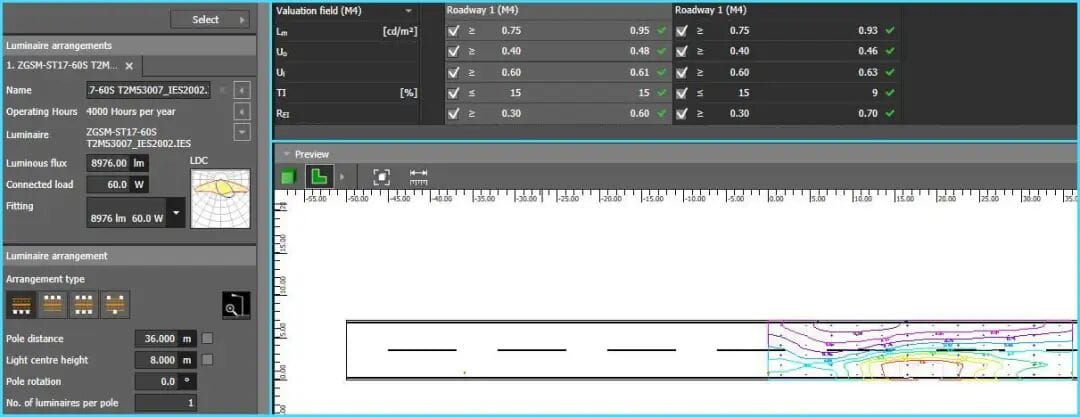
The above primarily introduces the concept of IESNA light distribution, covering Type I, Type II, and Type III distributions, as well as the concepts of short, medium, and long light distribution types, and briefly outlines their practical applications. Understanding these concepts can quickly determine the appropriate photometric type required for a project. For instance, Type II distribution is suitable for 1-2 lane roads, while the short distribution type is suitable for scenarios where the pole spacing is three times the mounting height. The medium distribution type is suitable for pole spacings of four to five times the mounting height. Of course, these are not absolute, and validation should be conducted using DIALux or other road lighting simulation software.
The Underlying Logic of Urban Road Lighting: Understanding How, Why, and Where Light is Shone
1. Introduction
Outdoor lighting design is a complex discipline that surpasses simple spatial illumination; it profoundly influences public safety, visual comfort, energy consumption, and the natural environment. Precisely controlling and distributing light is key to achieving these multifaceted goals. This article aims to provide a comprehensive analysis of key light distribution concepts—particularly cutoff fixtures (including full cutoff, cutoff, and semi-cutoff), non-cutoff fixtures, and batwing distributions—while strictly comparing them to established standards for street lighting in North America (primarily defined by the Illuminating Engineering Society of North America (IESNA)). By dissecting the technical definitions, characteristics, and typical applications of each type, this article will clarify the distinctions and synergies between them, offering valuable insights for professionals in urban planning, civil engineering, and lighting design to develop sustainable, compliant, and high-quality outdoor lighting solutions.
2. Understanding Cutoff Classification of Fixtures
The cutoff classification of fixtures defines the extent to which light is emitted above the horizontal plane, playing a crucial role in managing light pollution, glare, and light trespass. These classifications, historically defined by the Illuminating Engineering Society (IES), provide a framework for controlling upward light emissions.
2.1. Full Cutoff Fixtures
The light distribution of full cutoff fixtures is defined by two strict standards: first, the light intensity (candelas) at the nadir (directly below) at 90 degrees or above is zero, indicating that the fixture does not emit any light directly upwards 1. Second, the candela value at a vertical angle of 80 degrees or above per 1000 lumens of bare lamp does not exceed 100 (i.e., 10%) 1. These limits apply to all lateral angles around the fixture.
Full cutoff fixtures are designed to direct all light downward, thereby effectively minimizing skyglow (the brightening of the night sky) and light trespass (unwanted light spilling onto adjacent properties) 5. This characteristic makes them key to complying with dark sky regulations and preserving nighttime environments. Additionally, by strictly controlling high-angle light, they significantly reduce direct glare, enhancing visual comfort and safety for drivers and pedestrians 6. Their efficiency at precisely directing light only where illumination is needed also assists in energy conservation 6. Thus, many local regulations and environmental standards across North America mandate or strongly recommend the use of full cutoff fixtures 5.
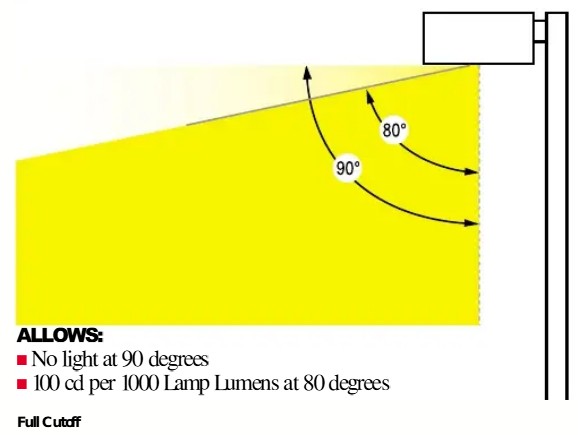
2.2. Cutoff Fixtures
The light distribution of cutoff fixtures is defined by specific candela limits: the candela value at a vertical angle of 90 degrees does not exceed 25 (2.5%) 2. At the nadir, the candela value at a vertical angle of 80 degrees does not exceed 100 (10%) 2. These limits apply to all lateral angles. While a small amount of light is allowed above 90 degrees, cutoff fixtures still significantly control upward light compared to semi-cutoff or non-cutoff fixtures, thereby assisting in reducing light pollution.
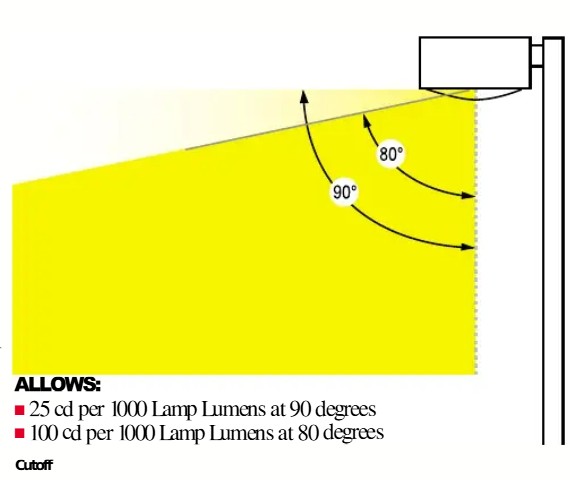
2.3. Semi-Cutoff Fixtures
Semi-cutoff fixtures have looser restrictions on upward light: the candela value at a vertical angle of 90 degrees does not exceed 50 (5%) 2. At 80 degrees, the candela value does not exceed 200 (20%) 2. These limits apply to all lateral angles. Compared to full cutoff or cutoff fixtures, semi-cutoff fixtures emit more light at high angles, increasing the potential for glare and skyglow. They are generally not recommended for environmentally sensitive areas or situations requiring strict control of light pollution.
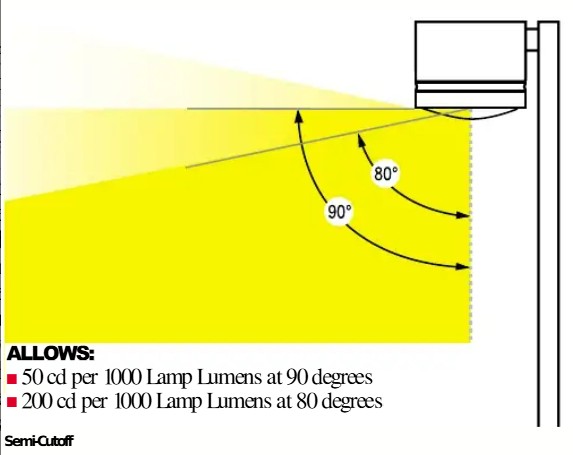
2.4. Non-Cutoff Fixtures
Non-cutoff fixtures are characterized by the absence of light intensity (candelas) restrictions above their maximum candela region 2. These fixtures emit light in all directions, including significant amounts directly upwards and horizontally. This lack of control leads to severe light pollution (skyglow), substantial light trespass into adjacent properties, and often produces uncomfortable glare 9. Due to growing environmental concerns and regulatory efforts to control light pollution, their use is increasingly restricted or prohibited in many jurisdictions 6.
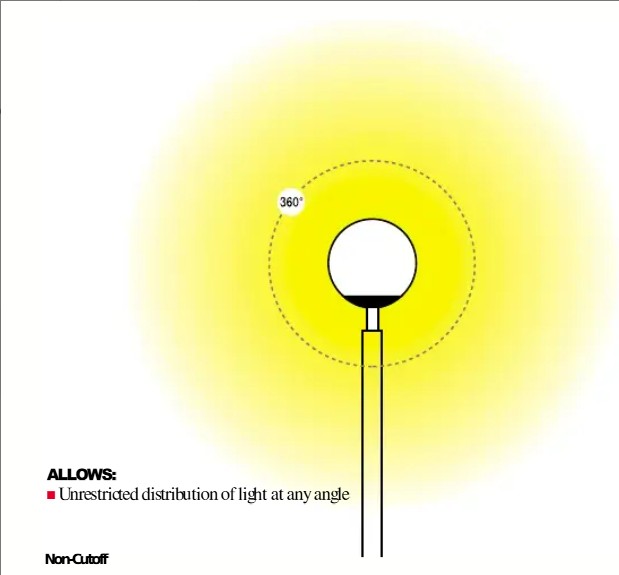
The evolution from non-cutoff to full cutoff fixtures represents a thoughtful advancement in lighting engineering and regulatory framework aimed at mitigating the negative impacts of outdoor lighting. This trend emphasizes the growing importance of environmental responsibility and enhancement of visual quality in modern lighting design. Unrestricted light (characteristic of non-cutoff fixtures) leads to issues such as glare, light spillage onto adjacent properties, and widespread light pollution 9. Conversely, stricter cutoff classifications, like full cutoff, are engineered to address these issues, aiming to “reduce light pollution,” “minimize skyglow,” “reduce glare,” “enhance visual comfort,” and “increase energy efficiency” 5. This evolution in classification is a direct response from the industry and regulatory bodies (such as the International Dark-Sky Association and IES RP-33) to the recognition of light pollution and glare as significant issues, driving and establishing stricter standards to promote more responsible and sustainable lighting practices. It indicates that lighting design has shifted from merely providing illumination to offering “high-quality” lighting that considers its broader environmental and human impacts.
It is noteworthy that the traditional cutoff classification system is being replaced by the BUG (Backlight-Uplight-Glare) rating system 3. This transition marks a movement towards a more detailed, comprehensive, and actionable approach to assessing lighting performance, recognizing that uplight is only one component of light pollution and trespass. The traditional cutoff system primarily focuses on the emission of light at angles above 80° and 90° (uplight). However, the BUG rating divides spherical light distribution into three different zones: “Up,” “Front,” and “Back,” quantifying the amount of light in each zone 3. This means it evaluates not only uplight but also light spill to the back (backlight, leading to trespass) and glare (light emitting at high angles forward and potentially causing discomfort). This shift illustrates that controlling uplight, while important, is insufficient for achieving truly comprehensive and responsible outdoor lighting. Backlight can lead to significant light trespass onto nearby properties, and glare directly affects visual comfort and safety. The BUG rating offers a more comprehensive and nuanced framework for designers and regulators to address all major forms of light pollution and disturbances. This allows for more precise selection and design of fixtures, leading to better overall lighting quality, enhanced safety, and improved environmental management through a transition from a simple pass/fail system to a graded, multi-dimensional assessment.
Table 1: Comparison of Cutoff Fixture Classification Characteristics
|
Classification Type |
Candela Limit at 90° (per 1000 bare lamp lumens) |
Candela Limit at 80° (per 1000 bare lamp lumens) |
Primary Features / Uplight Control |
Relevant Impacts |
|
Full Cutoff |
0 1 |
Not exceeding 100 (10%) 1 |
Zero uplight |
Excellent dark sky compliance, minimal glare, minimal light pollution |
|
Cutoff |
Not exceeding 25 (2.5%) 2 |
Not exceeding 100 (10%) 2 |
Very little uplight |
Good glare control, reduced skyglow |
|
Semi-Cutoff |
Not exceeding 50 (5%) 2 |
Not exceeding 200 (20%) 2 |
Moderate uplight |
Potential for glare and light trespass |
|
Non-Cutoff |
Unrestricted 2 |
Unrestricted 2 |
No uplight restrictions |
High risk of light pollution and glare |
3. Batwing Distribution
Batwing distribution represents a unique optical design strategy aimed at optimizing light quality and uniformity within the illuminated area. Unlike cutoff classifications that control uplight or the IESNA types that define the overall shape of light on surfaces, batwing distribution focuses on the uniformity of illumination.
3.1. Definition and Unique Profile
Batwing distribution is characterized by its ability to produce exceptionally uniform light output over a wide beam angle range 12. Its name “batwing” derives from the unique light intensity profile shape which resembles a bat’s wings when plotted on a polar graph, showing two peaks of intensity on either side of the nadir 12.
This unique distribution is typically achieved through the integration of specially designed diffusers or advanced optical elements within the fixture. These optical components work by breaking down the light emitted from LED sources into a series of small, evenly spaced beams. This engineered diffusion process transforms the more common “hotspot” distribution (where light is brightest in the center and fades quickly towards the edges) into a significantly more uniform light output 12. Additionally, some batwing designs utilize optical films to achieve “double-angle-bent light intensity” to meet specific illumination needs 13.
3.2. Advantages and Applications
Batwing distribution has several significant advantages over traditional light patterns:
-
More uniform light output: It ensures consistency in illumination levels across the entire beam angle range, minimizing changes in brightness and reducing the occurrence of dark spots 12.
-
Reduced hotspots: By eliminating concentrated areas of light, batwing distribution alleviates visual discomfort and creates a more aesthetically pleasing lighting environment 12.
-
Improved visual comfort and glare-free environment: The even distribution of light significantly reduces strong contrasts and direct glare, providing users with a more comfortable and ergonomic visual experience 12.
-
Increased productivity and mood: Studies show that comfortable, glare-free, and uniform lighting environments can positively influence user productivity and overall well-being across various settings such as offices, retail spaces, classrooms, and libraries 12.
Batwing distribution is an excellent choice for a wide range of applications requiring uniform, glare-free conditions:
-
Commercial and industrial spaces: Offices, retail environments, classrooms, and libraries benefit from shadow-free and hotspot-free lighting, enhancing focus and reducing eye strain 12.
-
Residential lighting: It helps create a more comfortable and warm atmosphere in homes.
-
Indirect lighting: Particularly effective when used with suspended indirect fixtures, light is directed to the ceiling to indirectly illuminate the space. This creates a broad, uniform pattern of reflected light, further enhancing uniformity and reducing direct glare 12.
Batwing distribution is an optical design feature that can be integrated into fixtures rather than being an independent classification system like cutoff or IESNA types. It addresses light quality and uniformity within the illuminated area, serving as a complementary function to broader classification systems. This distinction is crucial: batwing is not a replacement for IESNA or cutoff classifications but rather a sophisticated optical engineering solution that can be integrated into fixtures meeting specific cutoff and IESNA requirements. For example, a full cutoff fixture designed for a parking lot (e.g., IESNA Type V) may utilize batwing optical elements to ensure an evenly bright circular light pattern throughout the area without uncomfortable hotspots. This highlights that effective lighting design involves multiple overlapping considerations: controlling spill light (cutoff), shaping the illuminated area (IESNA), and optimizing light quality within that area (batwing).
The development and adoption of batwing distribution reflect a design philosophy that has transcended simply quantitative illumination (e.g., achieving a certain illuminance level), prioritizing qualitative aspects of lighting such as visual comfort and overall user experience. This marks a maturation of lighting design, where human factors are increasingly integrated into technical specifications. Traditional lighting design focused primarily on achieving minimum illuminance levels. However, “hotspots” and “glare” are recognized as issues leading to “discomfort and fatigue,” “visual strain,” and the creation of “uninviting” environments. The advantages of batwing (uniformity, glare reduction, enhanced productivity) directly address these qualitative deficiencies 12. This indicates a shift in priorities in lighting design. While meeting quantitative light levels remains important, there is a growing awareness that the “quality” of light distribution—how evenly and comfortably light is delivered—is equally vital for human well-being, task performance, and overall satisfaction in lighting spaces. This represents a more comprehensive, human-centered approach to lighting design.
4. North American Street Lighting Standards: IESNA Classifications
The Illuminating Engineering Society of North America (IESNA) has developed a fundamental classification system that prescribes how light is distributed on horizontal surfaces, which is critical for the design of roads, parking lots, and other outdoor areas across North America. This system provides a standardized language for describing fixture performance.
4.1. Overview of IESNA Classification System
The IESNA classification system is primarily based on the shape and extent of the lighting area produced by the fixture 8. It provides essential guidance for the design and installation of various outdoor lighting systems, including roads, sidewalks, and parking lots 8. The classification determines light distribution by measuring where most of the light falls on a standardized grid, emphasizing points of highest and 50% candela intensity (light intensity distribution). The system considers both lateral light distribution (across the road) and vertical light distribution (along the road direction) 8.
The comprehensive standard for lighting on roads and parking facilities in North America is ANSI/IES RP-8 (Recommended Practice for Roadway and Parking Facility Lighting). This document compiles numerous previous independent standards from IES and provides detailed guidance on design, maintenance, energy efficiency, environmental impact, and safety for various roadway and pedestrian applications 11.
4.2. Lateral Light Distribution Types (Type I, II, III, IV, V, VS)
These classifications define how light is laterally distributed along a road or lighting area, characterized by the point where the fixture reaches 50% of its light intensity 8.
-
Type I:
-
Characteristics: Provides a narrow symmetrical or asymmetrical elliptical light pattern, typically with a main beam angle of around 15 degrees. The 50% candela trajectory falls between one installation height (MH) on the house side and one installation height on the street side 8.
-
Applications: Most suitable for narrow, elongated areas such as sidewalks, narrow pathways, boundary lighting, and single-lane roads 8.

-
Type II:
-
Characteristics: Features a narrow asymmetrical pattern with a preferred lateral width of 25 degrees. The 50% candela trajectory falls between one installation height on the street side and 1.75 times the installation height 8. This type is usually suitable for fixtures located on the near side or nearby of relatively narrow roads where the width does not exceed 1.75 times the design installation height 9.
-
Applications: Suitable for 1-2 lane roads, major corridors, highways, wide sidewalks, small side streets, jogging paths, and bike lanes 8.

-
Type III:
-
Characteristics: Provides a wide asymmetrical pattern, preferably with a lateral width of 40 degrees, designed to project light outward and to the sides. The 50% candela trajectory falls between 1.75 times the installation height and 2.75 times the installation height 8. This type is typically mounted on the side of the area to be illuminated, where the width of the illuminated area should normally be less than 2.75 times the pole height 16.
-
Applications: Often used in major corridors, highways, parking lots, and large open areas requiring broader coverage 8.
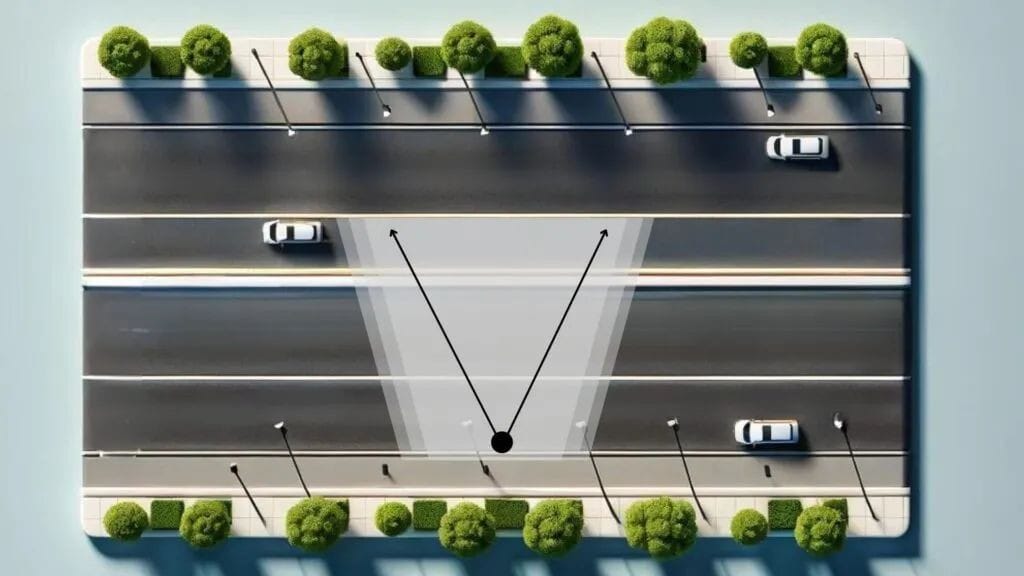
-
Type IV:
-
Characteristics: Exhibits an asymmetrical forward-throw pattern, preferably with a lateral width of 60 degrees, providing strong and uniform lighting over a range from 90 to 270 degrees. The 50% candela trajectory falls between 2.75 times the installation height and 3.75 times the installation height 8. It emits an elliptical light pattern, directing more forward with a narrower width than Type III, making it highly effective in controlling light spillage 8. It is designed for mounting on the sides of wide roads, where the width does not exceed 3.7 times the installation height 9.
-
Applications: Best suited for peripheral applications requiring mounting on walls or poles, such as parking lots, plazas, and building exteriors, where light needs to be primarily directed forward and strict control over backward spillage is necessary 8. It emits light in a semi-circular pattern 21.

-
Type V:
-
Characteristics: Produces a completely symmetrical circular light pattern with equal intensities at all lateral angles 4. The 50% candela trajectory is circularly symmetrical around the fixture 8.
-
Applications: Most suitable for illuminating large open areas from a central mounting point, such as parking lots, intersections, parks, and general work or task areas where light needs to be evenly projected in all directions 4.
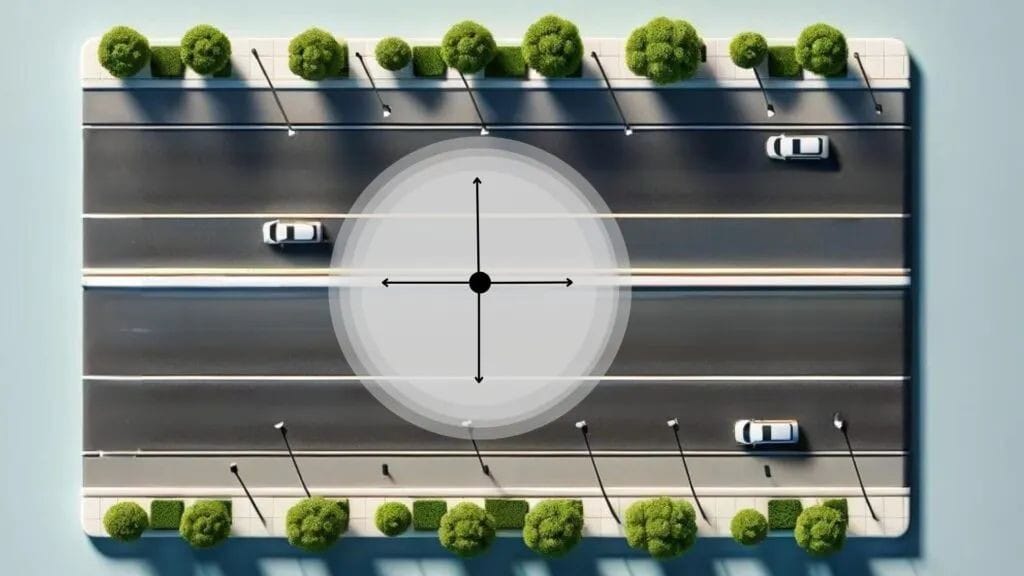
-
Type VS:
-
Characteristics: Similar to Type V but produces a symmetric square light pattern with consistent intensities at all lateral angles 4.
-
Applications: Suitable for large areas requiring uniform square illumination, such as parking lots and public squares 9.
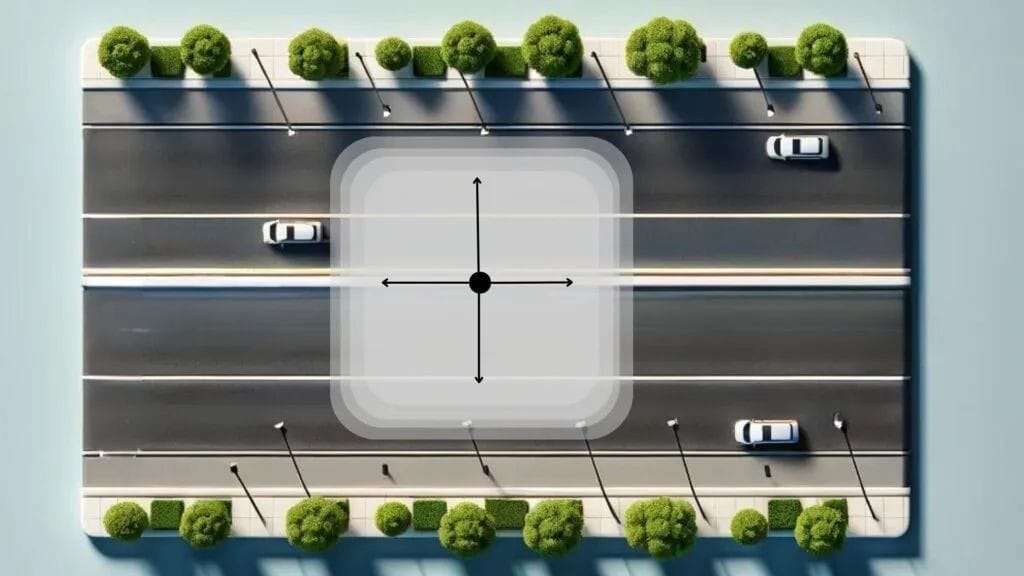
Table 2: IESNA Lateral Light Distribution Types (I-V/VS)
|
IESNA Type |
Half-Maximum Candela Point Range (in MH, street side/house side) |
Preferred Lateral Width (degrees, where applicable) |
General Light Distribution Pattern |
Major Applications |
|
Type I |
1 MH on house side to 1 MH on street side 8 |
About 15 15 |
Narrow symmetrical or asymmetrical |
Sidewalks, narrow paths, single-lane roads |
|
Type II |
1 MH street side to 1.75 MH 8 |
25 21 |
Narrow asymmetrical |
1-2 lane roads, wide sidewalks, bike lanes |
|
Type III |
1.75 MH to 2.75 MH 8 |
40 16 |
Wide asymmetrical |
Major corridors, highways, parking lots |
|
Type IV |
2.75 MH to 3.75 MH 8 |
60 9 |
Asymmetrical forward throw |
Wall-mounted applications, parking lot peripheries, plazas |
|
Type V |
Circularly symmetrical around the fixture 8 |
No specific angle, 360° symmetrical 21 |
Circular symmetrical |
Parking lots, intersections, large open areas |
|
Type VS |
Essentially the same across all lateral angles 14 |
No specific angle, 360° symmetrical 4 |
Square symmetrical |
Large squares, parking lots |
4.3. Vertical Light Distribution Types (Very Short, Short, Medium, Long, Very Long)
These classifications define how light is vertically distributed along the road based on the position of the maximum candela point 8. They are critical for determining appropriate pole spacing and ensuring uniform lighting along roadways.
-
Very Short (VS): Maximum candela point falls between 0 to 1.0 times the installation height along the road 8. Recommended pole spacing is approximately 1 times the installation height 14.
-
Short (S): Maximum candela point falls between 1.0 to 2.25 times the installation height along the road 8. Fixtures with “S” classification are generally suitable for situations where the pole spacing is less than 2.25 times the installation height 8.
-
Medium (M): Maximum candela point falls between 2.25 to 3.75 times the installation height 8. This type is suitable for situations where pole spacing is between 2.25 to 3.75 times the installation height 8.
-
Long (L): Maximum candela point falls between 3.75 to 6.0 times the installation height 8. Fixtures with “L” classification are suitable for larger pole spacing, specifically 3.75 to 6.0 times the installation height 8.
-
Very Long (VL): Maximum candela point falls beyond 6.0 times the installation height 8.
Table 3: IESNA Vertical Light Distribution Types (VS, S, M, L, VL)
|
IESNA Vertical Type |
Maximum Candela Point Range (along the road direction in MH) |
Recommended Pole Spacing (MH) |
Major Applications/Implications |
|
Very Short (VS) |
0 – 1.0 8 |
1 14 |
Very small pole spacing |
|
Short (S) |
1.0 – 2.25 8 |
1.0 – 2.25 14 |
Smaller pole spacing |
|
Medium (M) |
2.25 – 3.75 8 |
2.25 – 3.75 14 |
Medium pole spacing |
|
Long (L) |
3.75 – 6.0 8 |
3.75 – 6.0 14 |
Larger pole spacing |
|
Very Long (VL) |
> 6.0 8 |
> 6.0 |
Very large pole spacing |
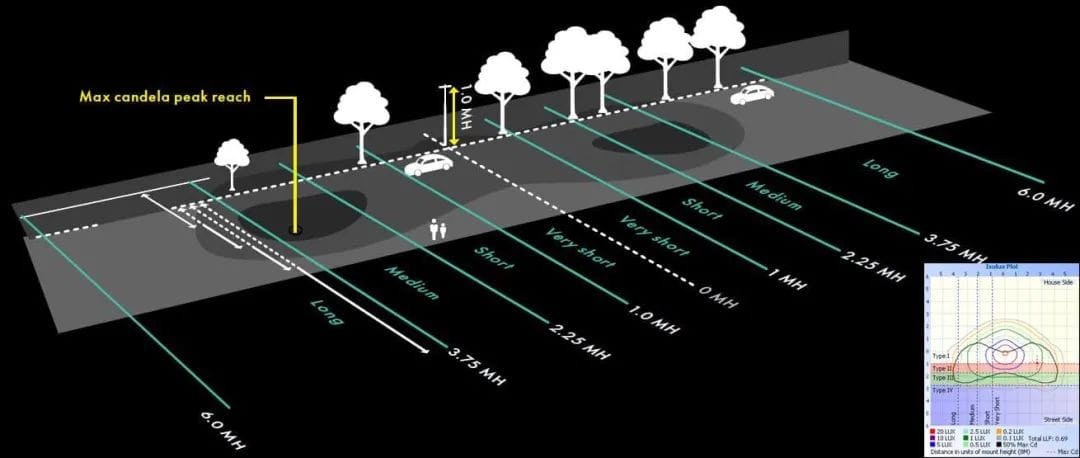
While the IESNA classifications are foundational, they serve more as guidelines rather than rigid rules. Their effective application requires consideration of numerous site-specific variables, underscoring the critical role of advanced lighting design tools and expert judgment in achieving optimal illumination. Several resources explicitly state that IESNA types are “guidelines” or “not fixed rules” and are influenced by factors like “fixture mounting height, tilt angle, arm length, and fixture-to-curb distance,” as well as “fixture layout and road conditions” 8. Documents also note the importance of “photometric data” and “modeling” in optimizing light distribution 15. The theoretical light distribution defined by IESNA types can change significantly due to specific installation parameters. For instance, incorrect mounting height or tilt angle may result in insufficient uniformity, excessive glare, or inefficient light distribution, even if the “correct” IESNA type is chosen. This complexity demands detailed photometric analysis and modeling, indicating that effective lighting design is an iterative and intricate process. It is not merely selecting a fixture type from a catalog. Designers must integrate theoretical knowledge (IESNA standards) with practical site conditions, validating their selections through advanced modeling tools. This emphasizes the value of expert lighting professionals in navigating these complexities to provide truly optimized and high-performance lighting solutions.
The IESNA system provides a solid framework for optimizing light coverage and pole spacing through its comprehensive classification of lateral and vertical light distribution. This dual classification directly contributes to improving energy efficiency and safety in roadway lighting projects. IESNA classifies light based on “lateral” (crossing the road, related to road width and coverage) and “vertical” (along the road direction, related to pole spacing) distribution 8. Lateral types (I-V/VS) match road widths (e.g., Type I for single lanes, Type II for double lanes, Type III for highways, Type V for large area lighting). Vertical types (S, M, L) correlate directly with “recommended pole spacing” and “pole height” 8. By precisely defining how light propagates laterally and vertically along the road, IESNA empowers designers to choose fixtures that minimize light overlap (wasting energy) and eliminate dark spots (affecting safety and visual comfort). For instance, opting for “long” vertical distribution can enable larger pole spacings, which can significantly reduce the number of poles and fixtures required for a given segment. This directly impacts initial installation costs and long-term energy consumption 8. Conversely, misjudging vertical distributions may lead to over-lighting or insufficient coverage between poles. The integration of lateral and vertical classifications allows for a highly optimized lighting design that is both functionally effective and resource-efficient. This optimization is crucial for achieving the goals outlined in standards like ANSI/IES RP-8-22, which include “minimizing energy use,” “enhancing driver visual quality,” and “providing high-quality light and increasing the visibility contrast of hazards” 18. It represents a systematic, scientific approach aimed at balancing lighting needs with economic feasibility, safety, and environmental impact.
5. Comparative Analysis and Design Considerations
Effective outdoor lighting design in North America reflects the complex interplay of various classification systems and optical characteristics. Understanding how cutoff fixtures, non-cutoff fixtures, batwing distributions, and IESNA classifications interact is crucial for developing optimal, compliant, and sustainable lighting solutions.
5.1. Interaction Between Cutoff Classifications and IESNA Types
Cutoff classifications (full cutoff, cutoff, semi-cutoff, non-cutoff) primarily control the amount of light emitted above the horizontal plane, serving as key mechanisms for controlling light pollution and glare 1. In contrast, IESNA types (I-V/VS) describe the shape and distribution of light on the ground, determining the effectiveness of illumination in areas such as roads or parking lots 8.
In contemporary North American street lighting, there is an overwhelming emphasis on using full cutoff fixtures. This preference is driven by stringent dark sky initiatives, environmental protection goals, and the desire to minimize light trespass and glare 5. These full cutoff fixtures are subsequently designed with specific IESNA lateral and vertical distributions (for example, full cutoff Type III medium distribution fixtures). The “cutoff” aspect ensures environmental responsibility by preventing light from spilling upwards, while the “IESNA type” ensures light is functionally directed and distributed to the target area (e.g., a multi-lane highway or large parking lot). These two systems work synergistically: cutoff addresses “where light should not go,” while IESNA addresses “where light should go and how it should be distributed.”
5.2. Integration of Batwing Distribution with IESNA Classifications
Batwing distribution itself is neither an IESNA classification nor a cutoff classification. Instead, it is a specialized optical design feature aimed at enhancing the “quality” and “uniformity” of light within the illuminated area 12. Its primary goal is to eliminate hotspots and provide a glare-free, comfortable lighting environment.
Batwing optical elements can be seamlessly integrated into fixtures with various IESNA distributions, particularly those designed for large-area coverage. For example, fixtures creating a symmetrical circular pattern (IESNA Type V) may be equipped with batwing optical elements 9. This combination creates a circular light pattern that is not only symmetrical but also exceptionally uniform without discomforting hotspots, making it highly suitable for areas requiring consistent lighting such as large plazas, central intersections, or open industrial spaces 9. Similarly, it may also be found in Type III distributions 23. This illustrates how batwing can serve as a qualitative enhancement within the quantitative framework of IESNA.
5.3. Comprehensive Considerations for North American Streetlight Projects
The selection of fixtures for streetlight projects in North America is a multidimensional optimization problem that necessitates a holistic approach balancing regulatory compliance (cutoff/BUG), functional requirements (IESNA lateral/vertical), and light quality (batwing, glare control), to achieve optimal safety, efficiency, and environmental management. This is seldom a singular, isolated choice.
-
Energy efficiency: Strategically selecting fixtures with appropriate cutoff classifications (especially full cutoff) and optimized IESNA types directly contributes to energy savings. By directing light precisely to the required areas and minimizing waste (uplight, backlight, spillover), overall energy consumption can be reduced 6. The widespread adoption of LED technology further enhances these efficiencies owing to its inherent design flexibility and higher lumen/watt output 9.
-
Visual comfort and safety: Minimizing glare and ensuring high illumination uniformity is crucial for visual comfort and safety. Proper cutoff fixtures can reduce discomfort glare for drivers and pedestrians, while appropriate IESNA types (potentially enhanced by batwing optical elements) ensure uniform light levels, reducing shadows and improving visibility of hazards 8. This directly correlates with reduced nighttime vehicle accident rates and increased pedestrian safety 18.
-
Dark sky initiatives and environmental impact: Adhering to full cutoff principles as well as guidelines from organizations like DarkSky International 7 and IES Recommended Practices (such as RP-33 Outdoor Environmental Lighting Recommended Practice) 5 is crucial for mitigating skyglow, protecting natural nightscapes, and preserving nocturnal ecosystems. This reflects a growing environmental awareness within lighting design.
-
Regulatory compliance: Local regulations, municipal codes, and state laws across North America often mandate specific cutoff classifications (e.g., full cutoff), and generally recommend or require various outdoor lighting applications to adhere to IESNA types 5. Compliance is not only a legal requirement but also a commitment to responsible urban development.
-
Economic benefits: In addition to environmental and safety advantages, optimized lighting design guided by IESNA standards and cutoff requirements can lead to significant economic benefits. This includes reduced initial installation costs (for example, by optimizing pole spacing with IESNA vertical types 8) as well as reduced long-term operating costs through energy savings 18. Moreover, well-lit areas can enhance public perceptions and potentially attract more foot traffic into commercial districts, boosting economic activity 18.
In practical applications, fixtures must meet multiple requirements: for example, they need to be “full cutoff” to comply with dark sky regulations and minimize light pollution 6; they must possess the appropriate IESNA lateral type (e.g., Type II or Type III) to effectively illuminate roads of specific widths 8; they should have the appropriate IESNA vertical type (e.g., medium or long) for optimal pole spacing along the road, ensuring uniformity and cost-effectiveness 8; and they might need to incorporate batwing optical elements to ensure surface light is evenly distributed without glare, enhancing visual comfort for users 12. Furthermore, all designs must comply with local municipal codes 5. This multifaceted requirement indicates that lighting designers cannot simply isolate one IESNA type. They have to consider the cutoff rating of the fixtures, their internal optical elements (such as batwing), and how these characteristics work together to meet the project’s various functional, environmental, regulatory, and aesthetic objectives. The complexity of finding fixtures that can simultaneously meet all these criteria often necessitates detailed photometric analysis and modeling tools 15. This highlights the critical role of expert consultation and comprehensive design processes in modern outdoor lighting.
6. Conclusion
Outdoor lighting design, particularly in North America, is a complex and nuanced field, centered on a profound understanding of various light distribution concepts. This article elucidates the fundamental distinctions between cutoff fixtures (full cutoff, cutoff, semi-cutoff), non-cutoff fixtures, and the specialized batwing distribution, providing a comprehensive comparison with the authoritative IESNA classification system for roadway lighting.
Cutoff classifications primarily serve as significant mechanisms for controlling light pollution and glare, where full cutoff fixtures represent the most stringent and environmentally friendly standards by directing all light downward. In contrast, non-cutoff fixtures significantly increase light trespass and skyglow due to the lack of such controls, resulting in their use becoming increasingly restricted. Batwing distribution differs from these broader classifications as it is an optical engineering solution focused on achieving exceptional uniformity and visual comfort within the illumination area, typically as a supplement to IESNA types for specific applications requiring hotspot-free lighting.
Ultimately, the best street lighting design in North America is a complex and comprehensive task. It requires integrating the precise, area-based distribution patterns specified by IESNA with strict cutoff requirements and, where appropriate, advanced optical solutions like batwing distribution. This integrated approach not only ensures functional lighting but also maximizes energy efficiency, enhances public safety and visual comfort, and maintains vital dark sky protection initiatives. Guiding the informed selection and professional design of fixtures under these integrated standards and considerations is crucial for creating sustainable, compliant, and high-quality outdoor lighting environments for communities.
How to Choose the LED Solar Lighting Tower with Hybrid Energy Options
Choosing the Right LED Solar Lighting Tower with Hybrid Energy Options
When selecting a solar lighting tower with mixed energy sources (solar, wind, diesel, grid), consider lighting requirements, range, functionality, runtime, and specific site conditions.
Quick comparison (three common models for initial screening)
- Small Solar Tower — Height: 6 m; Coverage: ~750 m²; Light output: ~33,000 lm; Battery pack: ~9.6 kWh; Run time: ~28.8 h (depends on brightness).
- Medium Mobile Lighting Trailer — Height: 9 m; Coverage: ~1,500 m²; Light output: ~66,000 lm; Battery pack: ~14.4 kWh; Run time: ~20 h.
- Large Portable Lighting Trailer — Height: 12 m; Coverage: ~2,200 m²; Light output: ~198,000 lm; Battery pack: ~28.8 kWh; Run time: ~20 h.
Note: Actual run times depend on brightness settings, load, weather, and site conditions. Use actual test data for precise planning.
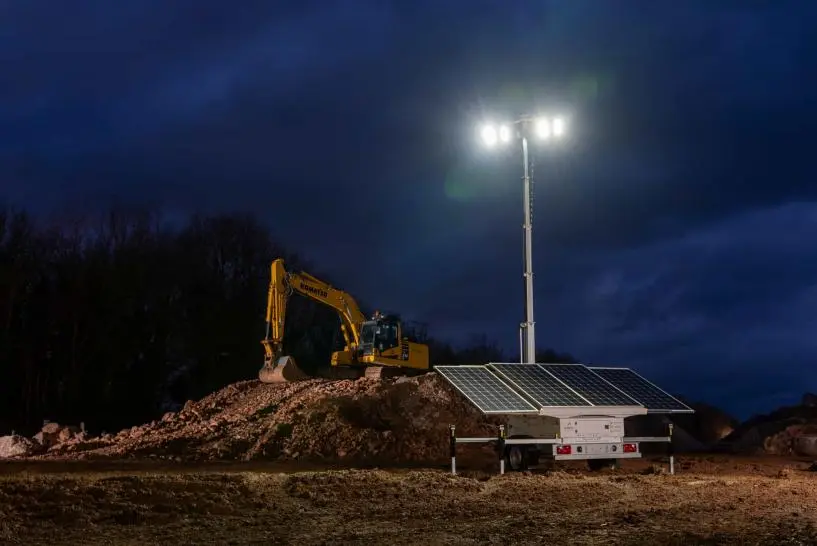
2. Choose Based on Illumination Coverage
3. Choose Based on Functionality
- 4G Monitoring: Optional for real-time monitoring in populated areas, construction sites, and sensitive locations to enhance security and asset protection.
- Emergency Rescue Applications: Opt for models with hybrid charging and prioritize the highest-capacity unit to maximize runtime and brightness for disaster response.
- Battery Type: Lead-acid batteries are commonly chosen for safety on outdoor work sites where lithium poses fire risks in unstable environments; LiFePO4 options are also available with appropriate safety measures.
- 5G Base Station Capability: Useful for remote or weak-signal regions, extending connectivity where needed.
4. Brightness and Energy Efficiency
- Brightness levels typically come in three tiers:
- 33,000 lm — suitable for small sites and low-density work zones.
- 66,000 lm — suitable for mid-sized work zones and security needs.
- 198,000 lm — for high-security environments or large-scale operations requiring broad visibility.
- Usage guidance: For small sites, lower brightness is often sufficient; for larger sites or higher security, higher brightness is preferable.
- Energy efficiency: Prioritize luminaire efficiency above 150 lm/W to reduce long-term operating costs.
5. Color Temperature and Rendering
- Color temperature choices: 5000–6500 K (cool white) for work areas and emergency operations; 2700–3000 K (warm white) for rest or safe zones where comfort matters.
- Color rendering (CRI): Higher CRI (>80) helps distinguish colors and details in critical environments such as emergency response, mining, construction, camping, safety checkpoints, signal stations, and security zones.
- Efficiency: LED luminaires with high efficacy support energy savings over time.
For environmental friendliness and performance, consider hybrid-energy towers that automatically switch among solar, wind, diesel, and grid sources to maintain lighting in variable conditions.
Understanding Different Hybrid Energy Solar Lighting Towers
Solar-Only Lighting Tower
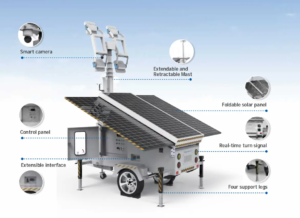
Advantages: Eco-friendly, low operating costs, simple maintenance.
- Features: 360° rotation and lighting
- Working Time: Up to 35 hours
Typical applications: Sunny regions, suitable for temporary or long-term lighting needs.
Representative models:
Solar Lighting Tower (Mobile),
Solar Lighting Tower (Variant 2).
Wind and Solar Hybrid Lighting Tower
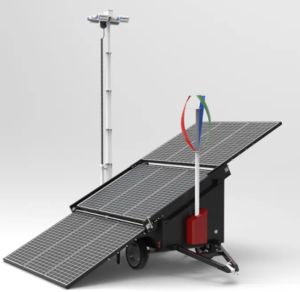
Advantages: Delivers stable power in wind-rich regions.
- Features: Up to 80 hours of working time
- Typical Applications: Remote Areas, Sites with Abundant Wind Resources, Emergency Lighting after Disasters
Representative models:
Sun-Wind Hybrid Solar Taiters and
Sunwind Mobile Solar Generator.
Diesel and Solar Hybrid Generator Tower
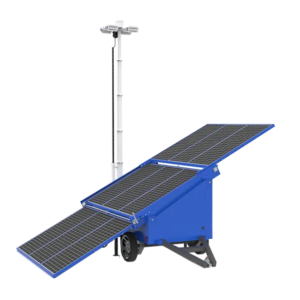
Advantages: Stable energy supply in areas without grid access.
- Features: Up to 80 hours of running time
- Typical Applications: Remote Construction, Mountain Rescue, Major Event Logistics Points
Representative model:
Sundiesel Hybrid Solar Tailers.
Grid-Powered Lighting Tower
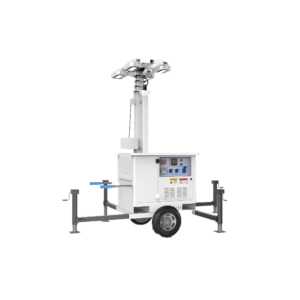
Advantages: Stable energy supply where electricity grids exist.
- Efficiency: 195 lm/W luminaire efficiency
- Illuminated Area: 1,200 m²
- Working Time: 35 hours
- Typical Applications: Large Construction Sites, Urban Infrastructure Locations, Event Venues
Representative model:
Electric Mobile Lighting Tower (T300, 6 m).
Quick Reference Selection Table
| Model | Height | Coverage Area | Light Output | Battery Capacity | Run Time (Typical) | Energy Options |
|---|---|---|---|---|---|---|
| Small Solar Tower | 6 m | 750 m² | 33,000 lm | 9.6 kWh | ~28.8 h | Solar, Hybrid, Diesel, Grid (Optional) |
| Medium Mobile Light Trailer | 9 m | 1,500 m² | 66,000 lm | 14.4 kWh | ~20 h | Solar, Hybrid, Diesel, Grid (Optional) |
| Large Portable Light Trailer | 12 m | 2,200 m² | 198,000 lm | 28.8 kWh | ~20 h | Solar, Hybrid, Diesel, Grid (Optional) |
Other Considerations
Maintenance and Servicing
- Regular inspection of luminaires and batteries
- Clean photovoltaic panels to maintain system performance
- Ensure overall system reliability through routine checks
Environmental Adaptability
- Protection Rating: Choose fixtures with high IP ratings (e.g., IP65) to withstand harsh weather conditions
Budget and Total Cost
- Consider upfront equipment costs, installation, and ongoing maintenance for a true total cost of ownership
Luxman portable solar lighting towers use high-efficiency solar panels, long-life lithium batteries, and high-brightness LED luminaires to ensure stable, long-term performance. Luxman also offers hybrid-energy models (e.g., solar+wind, solar+diesel) to meet diverse environments and requirements.
By following these guidelines, you can select the Luxman portable solar lighting tower that best fits your needs and ensure reliable illumination and long-term performance.
Ready to find the perfect model for your site? Contact Luxman today for a tailored solution.





